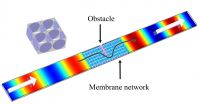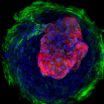Why kids' recovery times vary widely after brain injury
Damage to brain's wiring is likely culprit, finds UCLA/USC study
2015-07-15
(Press-News.org) Why do some youngsters bounce back quickly from a traumatic brain injury, while others suffer devastating side effects for years?
New UCLA/USC research suggests that damage to the fatty sheaths around the brain's nerve fibers--not injury severity-- may explain the difference. Published in the July 15 edition of the Journal of Neuroscience, the finding identifies possible biomarkers that physicians could use to predict higher-risk patients who require closer monitoring.
The study is the first to combine imaging scans with recording of the brain's electrical activity to reveal how damage to the protective coating around the brain's circuitry affects how quickly children and teens can process and recall information after a concussion or other head trauma.
"Just as electricians insulate electrical wires to shield their connections, the brain's nerve fibers are encased in a fatty tissue called myelin that protects signals as they travel across the brain," explained Dr. Christopher Giza, director of the UCLA Steve Tisch BrainSPORT Program and a professor of pediatrics and neurosurgery at UCLA's David Geffen School of Medicine and Mattel Children's Hospital. "We suspected that trauma was damaging the myelin and slowing the brain's ability to transmit information, interfering with patients' capacity to learn."
To test their hypothesis, the scientists assigned a series of mental tasks to 32 youngsters ages 8 to 19. Each had suffered a moderate to severe brain injury in the past five months. The tests evaluated the children's processing speed, short-term memory, verbal learning and cognitive flexibility.
The UCLA team recorded the kids' brains' electrical activity to test how quickly their nerve fibers could transmit information, and then imaged the wiring to assess its structural soundness.
When the scientists compared the patients' results to those of a matched control group of 31 healthy children, they discovered dramatic differences.
Half of the brain-injury group showed widespread damage to the myelin insulating their brain's circuitry. These patients performed 14 percent more poorly on the cognitive tests and their wiring worked three times slower than healthy children's.
Scans of the other 16 patients in the brain-injury group showed their myelin was nearly intact; and their brains were able to process information as quickly as healthy children's. They performed 9 percent better on the cognitive tasks than the youngsters with more myelin damage, though not as well as the uninjured kids.
"Our research suggests that imaging the brain's wiring to evaluate both its structure and function could help predict a patient's prognosis after a traumatic brain injury," said first author Emily Dennis, a postdoctoral researcher at USC's Keck School of Medicine.
"Our next step will be to explore how brain biomarkers change during a patient's first year of recovery when most people recapture some cognitive function," said principal investigator Robert Asarnow, a professor of psychiatry and psychology at UCLA's Semel Institute for Neuroscience and Human Behavior and College of Letters and Science.
INFORMATION:
Traumatic brain injury is the single most common cause of death and disability in children and teens, according to the U.S. Centers for Disease Control.
The research was supported by funding from the Eunice Kennedy Shriver National Institute of Child Health and Human Development, the National Institute of Biomedical Imaging and Bioengineering, and the National Cancer Institute.
ELSE PRESS RELEASES FROM THIS DATE:
2015-07-14
WASHINGTON, DC, July 14, 2015 -- When a sound wave hits an obstacle and is scattered, the signal may be lost or degraded. But what if you could guide the signal around that obstacle, as if the interfering barrier didn't even exist? Recently, researchers at Nanjing University in China created a material from polyethylene membranes that does exactly that.
Their final product, described this week in the Journal of Applied Physics, from AIP Publishing, was an acoustical "metamaterial" with an effective density near zero (DNZ). This work could help to endow a transmission ...
2015-07-14
A quick biological test may be able to identify children who have literacy challenges or learning disabilities long before they learn to read, according to new research from Northwestern University.
The study, publishing in the Open Access journal PLOS Biology on July 14th, centers on the child's ability to decipher speech -- specifically consonants -- in a chaotic, noisy environment. Preliterate children whose brains inefficiently process speech against a background of noise are more likely than their peers to have trouble with reading and language development when ...
2015-07-14
A yearlong study of more than 300 patients found that the investigational drug patiromer can reduce elevated blood-potassium levels--a common side effect of drugs essential in the treatment of chronic diabetic kidney disease.
The drug, given in this trial at one of four doses based on disease severity, returned blood potassium levels to normal when measured at four weeks and kept them under control for one year, the length of the trial. By quickly bringing potassium levels back to normal and keeping them there, patiromer can prevent life-threatening adverse events.
The ...
2015-07-14
The new guidelines for determining whether patients should begin taking statins to prevent cardiovascular disease issued in 2013 by the American College of Cardiology (ACC) and the American Heart Association (AHA) are more accurate and more efficient than an earlier set of guidelines in assigning treatment to adults at increased risk for cardiovascular events - including heart attacks and strokes - and identifying those whose low risk rules out the need to take statins. In their paper appearing in the July 15 issue of JAMA, a team led by Massachusetts General Hospital (MGH) ...
2015-07-14
An examination of the 2013 guidelines for determining statin eligibility, compared to guidelines from 2004, indicates that they are associated with greater accuracy and efficiency in identifying increased risk of cardiovascular disease (CVD) events and presence of subclinical coronary artery disease, particularly in individuals at intermediate risk, according to a study in the July 14 issue of JAMA.
The 2013 American College of Cardiology/American Heart Association (ACC/AHA) guidelines for the management of blood cholesterol represent a shift in the treatment approach ...
2015-07-14
A microsimulation model-based analyses suggests that the health benefits associated with the 10-year atherosclerotic cardiovascular disease risk threshold of 7.5 percent or higher used in the 2013 ACC-AHA cholesterol guidelines are worth the additional costs required to achieve these health gains, and that a more lenient threshold might also be cost-effective, according to a study in the July 14 issue of JAMA.
In November 2013 the American College of Cardiology and the American Heart Association (ACC/AHA) released new recommendations to guide statin treatment initiation ...
2015-07-14
Among patients with diabetic kidney disease and hyperkalemia (elevated potassium levels in the blood), a potentially life-threatening condition, those who received the new drug patiromer, twice daily for four weeks, had significant decreases in potassium levels which lasted through one year, according to a study in the July 14 issue of JAMA.
Patients at the highest risk for hyperkalemia are those taking renin-angiotensin-aldosterone system (RAAS) inhibitors with stage 3 or greater chronic kidney disease (CKD) who also have diabetes mellitus, heart failure, or both. Because ...
2015-07-14
An examination of state vaccination requirements for adolescents finds that the human papillomavirus (HPV) vaccine is currently required in only two states, many fewer than another vaccine associated with sexual transmission (hepatitis B) and another primarily recommended for adolescents (meningococcal conjugate), according to a study in the July 14 issue of JAMA.
Eight years after HPV vaccines were first recommended in the United States, vaccination coverage is substantially below the Healthy People 2020 target of 80 percent. Data from the U.S. Centers for Disease Control ...
2015-07-14
Berkeley -- Researchers at the University of California, Berkeley, in collaboration with scientists at the Gladstone Institutes, have developed a template for growing beating cardiac tissue from stem cells, creating a system that could serve as a model for early heart development and a drug-screening tool to make pregnancies safer.
In experiments to be published Tuesday, July 14, in the journal Nature Communications, the researchers used biochemical and biophysical cues to prompt stem cells to differentiate and self-organize into micron-scale cardiac tissue, including ...
2015-07-14
Boston, MA - A new study from Harvard T.H. Chan School of Public Health researchers has found that it would be cost-effective to treat 48-67% of all adults aged 40-75 in the U.S. with cholesterol-lowering statins. By expanding the current recommended treatment guidelines and boosting the percentage of adults taking statins, an additional 161,560 cardiovascular-related events could be averted, according to the researchers.
"The new cholesterol treatment guidelines have been controversial, so our goal for this study was to use the best available evidence to quantify the ...
LAST 30 PRESS RELEASES:
[Press-News.org] Why kids' recovery times vary widely after brain injury
Damage to brain's wiring is likely culprit, finds UCLA/USC study

